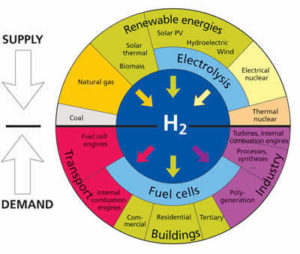“We would like to be still selling cars when there’s no more gasoline. And no one is coming to our door asking us to build a new electric car.”— Craig Scott, Toyota’s national manager of advanced technologies
NASA declared hydrogen a safe fuel long ago. In a previous article, I showed a pamphlet, indicating that my interest in hydrogen as a fuel goes back to 1986. I have to correct that. Cleaning out my desk, I came across this magazine from 1973 –the midst of the oil crisis. Most people knew very little about H2 at that time. Reading like Sci-Fi then, the article by Walt Woron describes various methods of converting IC engines to run on H2 — no mention of fuel cells, though. The almost four-page article had awakened my interest at that time – intensified by the invitation from Hydrogenics to a hydrogen/fuel cell workshop in 2005. (Article coming soon)
In the original version of this essay about H2 & FC History (a decade ago), Vito Agosta’s opinion piece continued at this point. The previous article contains a link to his writing. He talked about “Honda having introduced a hydrogen-powered car employing a fuel cell that offers many advantages, and Toyota and others soon to follow.” He was worried about “The dangers of fuel spills leading to combustion. Vehicle collision and subsequent fires and possible detonation are another danger, particularly when gaseous hydrogen is contained at high pressure, as has been recommended by some.” Those were Agosta’s concern.
Since his story appeared ‘in between’ the first two FCEVs being introduced, let me insert another in-between-story from journalist Jean-Jacques Cornaert, which I just found today. The introduction of the Mirai is already ‘history’, therefore I hope you will not fault me for this leap ahead. The article asks: Hydrogen? Is that safe? The quick answer: “Most definitely YES!”
In Cornaert’s article, Toyota explains: “In the improbable event of a leak, the Mirai contains highly sensitive sensors that detect minute amounts of hydrogen. These are placed in strategic locations for instantaneous detection of hydrogen. In the extremely unlikely event of a leak in the fuel system, the sensors immediately shut down the safety valves and the vehicle itself.” The article has a good explanation of the H2 system’s safety features.
In addition to the efforts of FCEV manufacturers, several United States Government Departments dissipate (pun intended) Agosta’s concern with wide-ranging regulations. One example is the extensive Safety and Health protocols from the United States Department of Labor, regulated by The Fuel Cell Technologies Office of the Department of Energy (DoE).
The European Union is supporting ongoing “research on fuel cells and hydrogen” and its many pages of regulations are as extensive as one might expect from bureaucrats. Japan’s regulations are in graphic form and easier on the eyes than those from Europe and the USA; those links were included for serious study only. The Korea Hydrogen Industry Association also has interesting graphics.
Since you have persevered this far, you are clearly comfortable with H2 as a fuel; the rest of the population should be assured by “companies like Walmart, Coca Cola, Verizon, Google, and Microsoft who are already using stationary fuel cells in their organizations,” some as a power source for their operation, others in their products.
These companies –and as you know, many others- are fastening their faith and future onto fuel cells. Notwithstanding, a number of insiders in academia and industry share Professor Agosta’s point of view. Regardless of the method of producing the hydrogen, which will ‘drive’ society and the resulting new industry, the Hydrogen Age is upon us. Commerce, combined with public opinion and market demand has the effect of an avalanche. That avalanche started in Asia and will sweep across America and Europe.
Graphic from Google
You may realise at this point that it is hardly possible to proceed in absolute chronological order; at times, it makes more sense to follow a chain of events, or issues, rather than dates. Following this distraction on the long path towards hydrogen fuel cells, now back to our timeline …
Next: Testing liquid versus gaseous fuel in Hydrogen & Fuel Cell History

